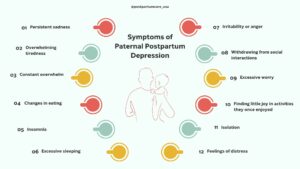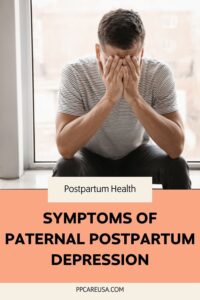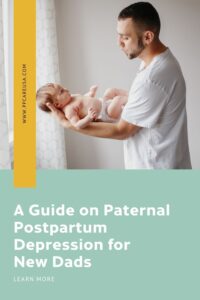Paternal postpartum depression impacts 1 in 10 new dads, turning the early months of fatherhood into a challenging experience. Understanding and recognizing this condition is crucial for timely support. In this article, we cover the symptoms, causes, and treatment options for paternal postpartum depression.
Key Takeaways
- Paternal postpartum depression affects approximately 10% of new dads and can significantly impair their emotional well-being and bonding with their newborn.
- Early recognition of symptoms such as persistent sadness, irritability, and social withdrawal is critical for timely intervention and treatment of paternal PPD.
- Risk factors for paternal PPD include a history of depression, hormonal changes, sleep deprivation, and relationship strain, emphasizing the need for proactive mental health support for new fathers.
Understanding Paternal Postpartum Depression

Postpartum depression (PPD) can also affect men. It is characterized as an episode of major depressive disorder that happens shortly after a child’s birth. It can strike unexpectedly, transforming the joy of fatherhood into an emotional struggle. Unlike the common perception that PPD is exclusive to new moms, paternal postpartum depression can affect new dads too, with significant implications for their well-being and their ability to bond with their newborn.
Paternal PPD can arise at any point within the first year after the child’s birth, making it a prolonged risk period for new fathers during the postnatal period. This extended period of vulnerability can lead to long-term emotional and behavioral problems if not addressed promptly. The ability to bond with the baby, a crucial aspect of early parenting, can be severely impacted, leading to further emotional distress in the context of maternal child health.
Statistics reveal that approximately 10% of new dads experience postpartum depression and anxiety, underscoring the importance of recognizing and supporting paternal mental health. When left untreated, paternal PPD can ripple through the family, affecting not just the father, but the entire family dynamic.
Understanding paternal PPD means recognizing that it is as real and debilitating as maternal depression. It is not a sign of weakness or incompetence, but rather a mental health condition that requires attention and treatment, just like other mental illness. Just as new moms are encouraged to seek help, new dads must also feel empowered to reach out for support.
Shedding light on paternal postpartum depression helps break the stigma and promotes a more inclusive understanding of mental health during the perinatal period. New fathers deserve the same compassion, support, and effective treatment as new mothers to navigate the challenges of early parenthood.
Recognizing the Symptoms in New Dads

Paternal postpartum depression can manifest in various ways, leading to significant emotional changes in new dads. These changes can be subtle or pronounced, but they often signal a deeper struggle that requires attention. Recognizing these symptoms early can make a significant difference in managing and treating paternal PPD.
Common symptoms of paternal postpartum depression include persistent sadness, overwhelming tiredness, and a feeling of being constantly overwhelmed. Changes in eating and sleeping patterns are also typical, with some dads experiencing insomnia while others might sleep excessively. These physical symptoms can be easily mistaken for the normal fatigue that comes with a new baby, but they often indicate a more profound issue.
Additionally, new fathers might experience irritability and anger, withdrawing from social interactions, and finding little joy in activities they once enjoyed. This withdrawal can extend to their interactions with their baby and partner, further compounding feelings of isolation and distress. Significant generalized anxiety disorder, often linked to feelings of entrapment and being overwhelmed, is another common symptom of excessive worry.
An estimated 1 in 10 fathers experience postpartum depression or postpartum anxiety, highlighting the importance of early identification. The impact on social life can be profound, as dads may pull away from friends and family, exacerbating loneliness. For many, the crying baby and the demands of new parenthood can trigger or worsen these symptoms, making everyday tasks feel insurmountable.
Recognizing these symptoms is crucial. Awareness allows new dads and their families to take proactive steps toward seeking help and support, ensuring the challenges of fatherhood are met with resilience and care.

Risk Factors for Paternal Postpartum Depression
A history of depression significantly increases the likelihood of postpartum depression in new fathers. For example, Mr. M, who had experienced a depressed mood since his early 20s, found himself battling paternal PPD after the birth of his child. Such a family history makes new dads more vulnerable to experiencing depressive symptoms during the postpartum period.
Up to 25 percent of first-time dads report symptoms consistent with postpartum depression, highlighting the prevalence among those with prior mental health issues. Hormonal changes, such as decreased testosterone and increased estrogen, have also been linked to shifts in parenting behavior and emotional well-being, contributing to the risk. Interestingly, higher testosterone levels in men can lead to increased parenting stress and partner aggression, further complicating their mental health landscape.
Fatigue and lack of sleep are primary drivers of psychosocial distress among new fathers, especially during stressful events. Nearly 18 percent of postpartum men have reported high levels of anxiety, often exacerbated by chronic sleep deprivation and sleep deprived individuals. This sleep deprivation can lead to physical signs of depression, adding to the psychological burden.
The adjustment to new fatherhood often leads to relationship strain, especially as partners become less available for emotional support due to the demands of infant care. This strain can create a cycle of stress and depression, making it harder for a new father to cope. An increasing trend in depression among new dads has been observed, indicating a potential link between relationship dynamics and mental health issues during the postpartum period.
Identifying these risk factors is essential for early intervention. Understanding what makes new dads more susceptible to paternal postpartum depression allows families and healthcare providers to develop targeted strategies for mental well-being during this critical time.
Screening Tools and Diagnosis
Early identification and treatment of paternal postpartum depression can be achieved through screening. The Edinburgh Postnatal Depression Scale (EPDS), adapted with a lower cutoff score for men, is one of the most commonly used tools for identifying fathers experiencing depression symptoms.
Other valid screening tools include the Patient Health Questionnaire (PHQ-9), which addresses postnatal depression and anxiety disorders. Clinicians should screen fathers during the first year after childbirth, especially if known risk factors are present. Early screening can lead to timely intervention, significantly improving outcomes.
Diagnosing paternal postpartum depression typically involves a clinical interview using the diagnostic and statistical manual (DSM-5) criteria to assess mental health status, as outlined by the American Psychiatric Association. A higher EPDS score indicates a greater level of depression symptoms, requiring further evaluation. Expanding screening practices into routine primary care can help reach more affected fathers and improve overall mental health outcomes.
Incorporating these screening tools into regular check-ups can help identify paternal PPD early, ensuring new dads receive the necessary support. Timely diagnosis and intervention can significantly improve the mental health and overall well-being of new fathers and their families.
Impact on Family Dynamics
Paternal postpartum depression can have far-reaching effects on family dynamics, influencing not just the father, but the entire family. Children of fathers with postpartum depression are more likely to face behavioral challenges, particularly from ages 3 to 5. This period is critical for child development, and the presence of paternal PPD can hinder father-infant communication and stimulation.
The overall quality of family life deteriorates with untreated paternal postpartum depression, leading to various relational harms. Negative parenting outcomes are amplified when both parents are affected by mood disorders, creating a challenging environment for children’s lives and emotional and behavioral development. Untreated paternal PPD can also lead to a range of future disorders in children, including anxiety and attention deficits.
Children living with a father who has depression in fathers face a significantly increased risk of developing emotional or behavioral problems. Research indicates a correlation between paternal depression and an increased risk of maternal depression, further complicating family dynamics. Fathers experiencing postpartum depression often withdraw from family interactions, which can increase the mother’s feelings of isolation.
Developmental delays associated with paternal depression include delays in behavioral, emotional, and social development in 4 and 5-year-old children. These impacts underscore the importance of addressing paternal PPD not just for the father’s sake, but for the well-being of the entire family. By understanding and addressing paternal PPD, families can work towards healthier interactions and better developmental outcomes for their children.
Treatment Options for Depressed Dads

Common treatment options for paternal postpartum depression include:
- Talk therapy
- Cognitive behavior therapy
- Interpersonal therapy
- Antidepressants
These therapies can be highly effective in managing depression symptoms and improving overall mental health. If self-help strategies are insufficient, professional treatment is necessary for managing paternal prenatal and postpartum depression and peripartum depression.
Treating paternal postpartum depression can improve the quality of life for both the father and the family and reduce emotional and behavioral problems in children. However, fathers who screen positive often show resistance to engaging with mental health services, hindering their treatment progress.
Treatment and support are available when postpartum depression and anxiety are recognized in new fathers, which can facilitate their recovery. By encouraging new dads to seek help, families can ensure that they receive the treatment they need to navigate the challenges of early parenthood effectively.
Supporting a Partner with Paternal Postpartum Depression
If a father experiences a noticeable change in personality, it is crucial to take it seriously and encourage professional support. Helping them seek medical attention immediately if they show signs of postpartum depression is vital. It’s common for postpartum depression to occur, and it is treatable.
Encouraging new dads to engage in baby care activities can help them feel more connected, which can alleviate some symptoms of depression. Family members should prioritize getting adequate rest, which can help alleviate some symptoms of depression. Providing emotional support and understanding can make a significant difference in helping a partner cope with paternal PPD.
Key supportive actions include:
- Encouraging new dads to engage in baby care activities to foster connection and reduce depression symptoms.
- Prioritizing adequate rest for family members to help alleviate depression symptoms.
- Providing emotional support and understanding to assist partners coping with paternal PPD.
Fostering a supportive environment allows partners to play a crucial role in the recovery process, ensuring new dads do not feel isolated or overwhelmed. Support groups, open communication, and social support help family functioning navigate this challenging period together.
Preventive Measures for Expectant Fathers
Key approaches to managing paternal postpartum depression include:
- Prioritizing sleep and regular exercise to alleviate symptoms.
- Engaging in open communication about feelings to reduce the stigma around seeking help.
- Implementing preventive measures for expectant fathers to mitigate the risk of postpartum depression.
Health care providers play a crucial role in preventive care, offering guidance and support to expectant fathers. By encouraging new dads to prioritize their mental health, we can create a more supportive environment for families. Open communication and proactive strategies can make a significant difference in preventing paternal PPD.
Summary
Paternal postpartum depression is a significant but often overlooked challenge that new dads may face. Recognizing the symptoms, understanding the risk factors, and seeking early intervention can make a profound difference in the lives of new fathers and their families. By fostering a supportive environment and encouraging open communication, we can help new dads navigate the challenges of early parenthood.
Understanding and addressing paternal PPD is not just beneficial for the father, but for the entire family. By taking proactive steps and seeking appropriate treatment, new dads can overcome this challenge and enjoy the joys of fatherhood. Let’s break the stigma and ensure that new fathers receive the care and support they deserve.
Frequently Asked Questions
What is paternal postpartum depression and when can it occur?
Paternal postpartum depression is a form of major depressive disorder that can arise in men following the birth of a child, typically within the first year. Recognizing its signs early is crucial for effective support and treatment.
What are the common symptoms of paternal postpartum depression?
Paternal postpartum depression commonly presents with persistent sadness, overwhelming tiredness, changes in appetite and sleep, irritability, social withdrawal, and significant anxiety. Recognizing these symptoms is crucial for seeking help and support.
What are the risk factors for paternal postpartum depression?
Paternal postpartum depression is often influenced by factors such as a history of depression, hormonal shifts, fatigue, sleep deprivation, and stress in relationships. Recognizing these risk factors is crucial for early intervention and support.
How is paternal postpartum depression diagnosed?
Paternal postpartum depression is primarily diagnosed through screening tools such as the Edinburgh Postnatal Depression Scale and thorough clinical interviews based on DSM-5 criteria. Timely diagnosis is crucial for effective support and treatment.
What treatment options are available for paternal postpartum depression?
For paternal postpartum depression, effective treatment options consist of talk therapy, cognitive behavior therapy, interpersonal therapy, and antidepressants. Seeking professional help is essential for recovery and well-being.
🍼 Want to learn more about postpartum recovery for the whole family? Schedule a consultation with our team today.
Pin This for Later:



Postnatal Depletion
Meet the Team
Our Services
Supplements
A virtual healthcare clinic that helps postpartum mamas recover from postnatal depletion syndrome with a holistic approach.

Get in touch